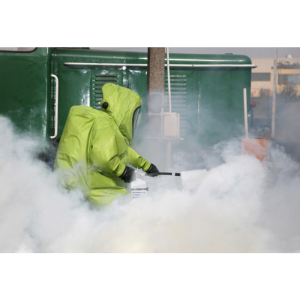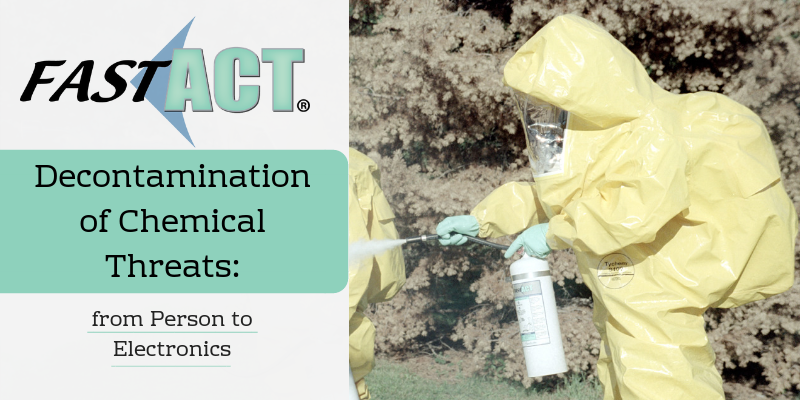Decontamination is a process of making any person, object, or area safe by absorbing, neutralizing, or destroying chemical agents released in the environment. Chemical Warfare Agents (CWAs) are very complex and destructive agents that can be deployed or released into an area causing significant issues to both public health & overall safety. Chemical agents can be classified as nerve agents, blood agents, choking agents, and TICs (Toxic Industrial Chemical) – each category of chemical agents contain different characteristics that create a lethal concoction.
Chemical threats may be dispersed in many different forms ranging from liquid form to vapor form, which can both have their own hazardous effects on the environment, human health, and on decontamination equipment. CWAs in vapor form can penetrate into the interior of decon equipment and damage the equipment if the chemical agent is highly corrosive. Whereas CWAs in liquid form can adhere to a surface, spread over the surface, and penetrate into tiny spaces such as cracks and crevices – this type of adsorption can cause changes to the properties of the material, which can affect the decontamination equipment. Decontamination of chemical threats can be a very challenging process and having the proper equipment and trained personnel can help to accomplish a complete decontamination of a chemical threat.
What is the Purpose of Decontamination?
 Decontamination is a multi-faceted topic that involves several components including health issues, hazardous materials (HAZMAT) issues, emergency response issues, and crime scene issues. This practice is set in place to facilitate the neutralization or destruction of hazardous chemicals that may get released into an environment.
Decontamination is a multi-faceted topic that involves several components including health issues, hazardous materials (HAZMAT) issues, emergency response issues, and crime scene issues. This practice is set in place to facilitate the neutralization or destruction of hazardous chemicals that may get released into an environment.
Decontamination practices offer a rapid solution to limiting the spread of contaminants from the “hot zone”, where chemicals affect a specific area. There are many components included in the decontamination process, such as cleaning contaminated victims from a wide spectrum of chemical threats and neutralizing a contaminated area from hazardous materials.
Unfortunately, the reality is that often times decon is only conducted as an afterthought after an incident occurs, and because of this, decon can sometimes be dismissed as not an integral or important part of the response procedure. And when decontamination procedures are not implemented it can lead to a very volatile environment that can be significantly hazardous to humans.
What are the Basic Principles of Decontamination?
Decontamination overall is essential to have for emergency responders, HAZMAT, and military members who are typically the individuals who are exposed to and on the scene at a contaminated area. The resources required to perform a proper and effective decontamination is fairly costly in terms of manpower, time, space and even material, but the benefits that decontamination provide to the safety of the environment and humans is invaluable.
The process of decontamination is composed of basic principles to help facilitate a successful decon application – these four basic principles include speed, need, limit, and priority. Of these four principles, speed is amongst the most crucial when it comes to decontamination. Contamination of a chemical threat on personnel or in a specific area can pose an immediate hazard and become lethal within minutes after contamination takes place. Therefore, implementing immediate action and decontamination practices will play a key role in the effect of a chemical release or outbreak.
What are the Three Main Levels of Decontamination?
Depending on the level of hazard, the amount of the chemical present, and the actual chemical that is at play can all lead to a specific form of decontamination that needs to be activated. There are two categories of decontamination that can be used during a chemical release – Passive or Active Decontamination. Passive decontamination is accomplished by exposing an object to high temperatures, sunlight, and wind, which is a very time-consuming process for decontamination. Whereas active decontamination is a process of removing and neutralizing liquid or solid contamination of CWAs, this is a rapid decontamination solution that most emergency responders will utilize during a chemical release.
The active decontamination process is subdivided into three main levels of decontamination – immediate, operational, and thorough.
- Immediate decontamination: Decon that is performed by the individuals and can include the decontamination of personal clothing and/or equipment. This can save lives, minimize casualties and limit the spread of contamination. It can also be performed on individual protective equipment to sustain personal protection.
- Operational decontamination: Decon that is performed by an individual and/or unit on a specific part of operational significant equipment. This helps to minimize contact, transfer hazard, and to sustain operations.
- Thorough decontamination: Decon that is performed by a unit to reduce contamination on personnel, equipment, material, and working areas to the lowest potential level.
All three levels of decontamination focus on both personnel decontamination and environment/surface decontamination. The process of decontaminating surfaces can be complex, as there are many factors you must take into consideration before containing and neutralizing the chemical threat. Many decontamination solutions require the identification of the chemical to properly neutralize the chemical threat, and this can be extremely time consuming. However, with the aid of a universal chemical decontamination solution, emergency-responders can quickly contain and neutralize the environment in which a chemical threat was present. FAST-ACT is a chemical decontamination provider that utilizes a proprietary formulation of non-toxic, high-performance specialty materials effective at neutralizing a wide range of toxic chemicals with the added capability of destroying CWAs.

FAST-ACT is revolutionary for liquid/vapor chemical decon with its ability to decontaminate a broad range of chemicals without the need of identifying the chemical at play. Thus, eliminating precious time wasted and minimizing health effects for those exposed.
How Do You Decontaminate Someone?
 Decontamination is most effective if victims first remove their clothing, as this has been shown to eliminate alone as much as 80-90% of all contamination. The effectiveness of removing clothes prior to decontamination rapidly decreases with time following exposure, so quick action should be taken following contamination. Victims are typically decontaminated in the water shower deluge of the decontamination corridor. Depending on the type of chemical exposure, the decontamination process can vary, the variations include the following:
Decontamination is most effective if victims first remove their clothing, as this has been shown to eliminate alone as much as 80-90% of all contamination. The effectiveness of removing clothes prior to decontamination rapidly decreases with time following exposure, so quick action should be taken following contamination. Victims are typically decontaminated in the water shower deluge of the decontamination corridor. Depending on the type of chemical exposure, the decontamination process can vary, the variations include the following:
- Vapor Chemical Threat: A victim that has been exposed to the vapor should rub with either their hands, a soft cloth, or a sponge to remove the contaminants, from head to toe.
- Liquid Chemical Threat: A victim that has been exposed to the liquid should use soap or a solution of detergent and water can be applied immediately to the skin.
Understanding and knowing the processes of implementing decontamination practices can be very vital to an emergency -responder who comes across a contaminated environment. Learning the purpose of decontamination and the best practices will help you to minimize the risks and contain a hazardous situation.


